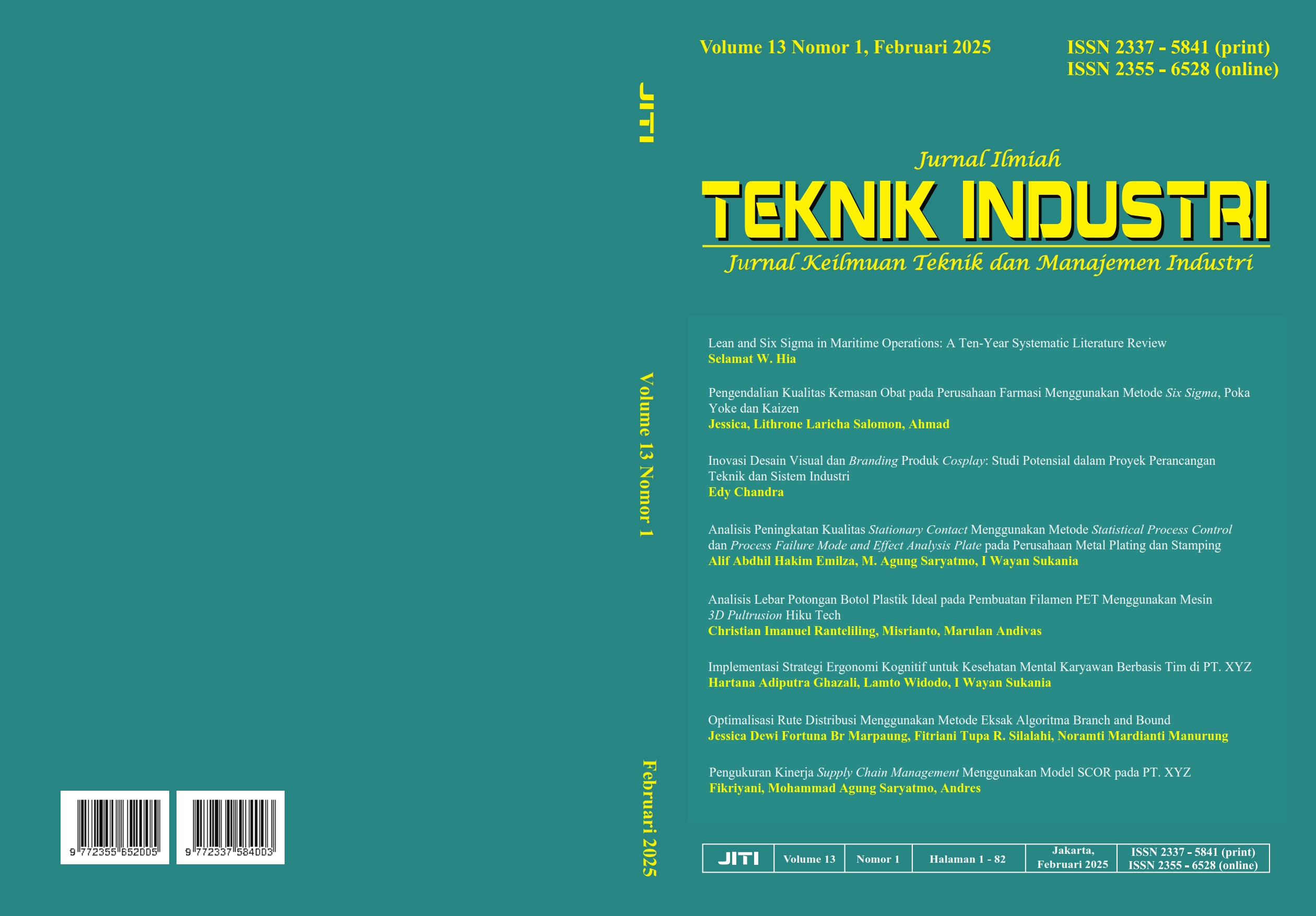ANALISIS LEBAR POTONGAN BOTOL PLASTIK IDEAL PADA PEMBUATAN FILAMEN PET MENGGUNAKAN MESIN 3D PULTRUSION HIKU TECH
Isi Artikel Utama
Abstrak
Hiku Tech 3D Pultrusion Machine is a PET filament making machine from PET plastic bottle waste designed by Industrial Engineering students of University of Balikpapan. The machine still needs adjustment in handling the size of PET plastic bottle pieces with different widths. The width of the cut can affect the quality of PET filament and the time of making PET filament, if the cut is too wide or narrow. This study aims to determine the ideal cut width of plastic bottles in PET filament making by looking at the quality of PET filament results and the effect of plastic bottle cut width on PET filament making time. This research uses the method of checking the quality of filament results and the simple linear regression method. The scoring results of the 8mm cut width produced a score of 2 for 23 samples, the 9mm cut width produced a score of 4 for 18 samples, and the 10mm cut width produced a score of 2 for 20 samples. The results of linear regression analysis state that the width of 8mm and 10mm pieces has no positive and significant effect on the time of making PET filaments, while the width of 9mm pieces has a positive and significant effect on the time of making PET filaments. Thus, in the manufacture of PET filaments with cut widths of 8mm, 9mm, and 10mm plastic bottles, it was found that the ideal cut width in the manufacture of PET filaments is a cut width of 9mm.
Rincian Artikel

Artikel ini berlisensiCreative Commons Attribution-NonCommercial-ShareAlike 4.0 International License.

All publications by Jurnal Ilmiah Teknik Indsutri (Jurnal Keilmuan Teknik dan Manajemen Industri ) [p-ISSN: 2337-5841, e-ISSN: 2355-6528] is licensed under a Creative Commons Attribution-ShareAlike 4.0 International License.
Referensi
[1] H.A. Latif, I.A. Rosid, G.S. Dewi, and M.G.D. Jatiningsih, “Optimasi Multi Parameter Mesin 3D Printer FDM untuk Material Thermoplastic Polyurethane Guna Menghasilkan Error Dimensi Terkecil Menggunakan Metode 2K Factorial Design,” J. Ilm. Tek. Ind., vol. 12, no. 1, pp. 41–49, 2024, [Online]. Available: https://journal.untar.ac.id/index.php/ industri/article/view/27105.
[2] A.K. Putra, F. Fidiyanto, B. Prakoso, R.Z. Armantya, M.K. Sandi, and F.H.S. Al Haris, “Perakitan 3D Printer Fused Deposite Modeling (FDM) Berbasis Arduino Mega 2560,” Gaung Inform., vol. 12, no. 2, pp. 123–133, 2019, [Online]. Available: https://jurnal. usahidsolo.ac.id/index.php/GI/article/view/380.
[3] H.A. Pamasaria, T.H. Saputra, A.S. Hutama, and C. Budiyantoro, “Optimasi Keakuratan Dimensi Produk Cetak 3D Printing berbahan Plastik PP Daur Ulang dengan Menggunakan Metode Taguchi,” JMPM (Jurnal Mater. dan Proses Manufaktur), vol. 4, no. 1, pp. 12–19, 2020, [Online].
[4] C.A. Rahmayani and Aminah, “Efektivitas Pengendalian Sampah Plastik Untuk Mendukung Kelestarian Lingkungan Hidup di Kota Semarang,” J. Pembang. Huk. Indones., vol. 3, no. 1, pp. 18–33, 2021, [Online]. Available: https://ejournal2.undip.ac.id /index.php/jphi/article/view/10231.
[5] C. Candra, N. Sutarna, M. Mustika, M.C. Utami, and N.D. Cahyani, “Pemanfaatan Sampah Plastik Melalui Ecobrick Di Desa Cikondang,” BERNAS J. Pengabdi. Kpd. Masy., vol. 4, no. 4, pp. 2731–2739, 2023, [Online]. Available: https://doi.org/10.31949/jb.v4i4.6640.
[6] M. Taufik, G.S. Lubis, and M. Ivanto, “Rancang Bangun Mesin Pultrusion Pembuat Filamen 3D Printing Berbasis Limbah Plastik Botol PET,” J. Teknol. Rekayasa Tek. Mesin, vol. 4, no. 1, pp. 1–8, 2023, [Online]. Available: https://jurnal.untan.ac.id/index.php/ jtm/article/view/60639.
[7] Kamaliah, “Pemanfaatan Limbah Sampah Plastik Menjadi Bata Beton,” Media Ilm. Tek. Lingkung., vol. 4, no. 2, pp. 41–46, 2019, [Online]. Available: https://journal.umpr.ac.id/ index.php/mitl/article/view/1063.
[8] K. Mikula, D. Skrzypczak, G. Izydorczyk, J. Warchoł, K. Moustakas, K. Chojnacka and A. Witek-Krowiak, “3D printing filament as a second life of waste plastics—a review,” Environ. Sci. Pollut. Res., vol. 28, no. 10, pp. 12321–12333, 2021, [Online]. Available: https://link.springer.com/article/10.1007/s11356-020-10657-8
[9] H. Tondi, “Rancang Bangun Mesin Ekstruder Filamen 3D Printer,” Skripsi Tek. Mesin, Fak. Teknol. Ind. Univ. Islam Indones., pp. 1–66, 2019, [Online].
[10] D.B. Santoso, “Laporan Akhir Rekayasa Mesin Pembuat Filamen dari Sampah Botol PET untuk 3D Printing,” Universitas Tidar, 2022. [Online]. Available: https://repositori.untidar.ac.id/index.php?p=fstream-pdf&fid=32735&bid=12620
[11] K. Minchenkov, A. Vedernikov, A. Safonov, and I. Akhatov, “Thermoplastic Pultrusion: A Review,” Polym., vol. 13, no. 2, pp. 1–36, 2021, [Online]. Available: https://www.mdpi.com/2073-4360/13/2/180
[12] A. Sinaga, “Rancang Bangun Mesin Pencacah Plastik Menggunakan Transmisi Puli dan Sabuk dengan Kapasitas 30 Kg,” Universitas HKBP Nommensen, 2021. [Online]. Available: http://repository.uhn.ac.id/handle/123456789/5905
[13] I. Tylman and K. Dzierzek, “Filament for a 3D Printer from Pet Bottles-Simple Machine,” Int. J. Mech. Eng. Robot. Res., vol. 9, no. 10, pp. 1386–1392, 2020, [Online].
[14] N. Umam, “Rancang Bangun Alat Pembentuk Filament 3D Printer dari Botol Plastik Merk Crystalin dan Club,” 2023, [Online]. Available: https://eprints2.undip.ac.id/id/eprint/16943/.
[15] Hanafi, I. Sujana, and R.A. Wicaksono, “Rancang Bangun Alat Ekstruder Dengan Pemanfaatan Limbah Plastik Polypropylene Dan Polyethylene Terephthalate Untuk Menghasilkan Filamen 3D Printing,” J. Teknol. Rekayasa Tek. Mesin, vol. 3, no. 1, pp. 20–26, 2022, [Online]. Available: https://jurnal.untan.ac.id/index.php/jtm/article/51308/ 75676591465.
[16] W. Kosasih, L.L. Salomon, Suhartono, M.A. Kartawidjaja, M. Mulyadi, "Optimization of Injection Molding Process Parameter Setting Using 3k General Factorial Design and Data Visualization," Jurnal Ilmiah Teknik Industri: Jurnal Keilmuan Teknik dan Manajemen Industri, vol. 11, no. 1, 2023.
[17] H. Purwanto, “Analisis Kepuasan Penumpang Terhadap Layanan Free Wifi di Terminal Bandara Udara XYZ dengan Menggunakan Regresi Linier dan SPSS,” JSI (Jurnal Sist. Informasi), vol. 7, no. 1, pp. 109–136, 2020, [Online]. Available: https://journal.universitassuryadarma.ac.id/index.php/jsi/article/ view/386.



